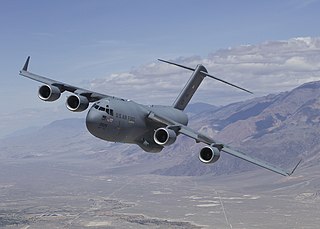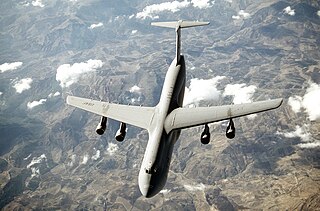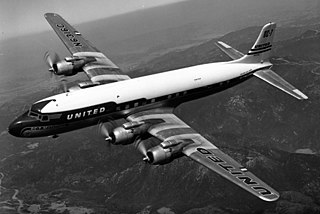
The McDonnell Douglas/Boeing C-17 Globemaster III is a large military transport aircraft that was developed for the United States Air Force (USAF) from the 1980s to the early 1990s by McDonnell Douglas. The C-17 carries forward the name of two previous piston-engined military cargo aircraft, the Douglas C-74 Globemaster and the Douglas C-124 Globemaster II.

The Lockheed C-5 Galaxy is a large military transport aircraft designed and built by Lockheed, and now maintained and upgraded by its successor, Lockheed Martin. It provides the United States Air Force (USAF) with a heavy intercontinental-range strategic airlift capability, one that can carry outsized and oversized loads, including all air-certifiable cargo. The Galaxy has many similarities to the smaller Lockheed C-141 Starlifter and the later Boeing C-17 Globemaster III. The C-5 is among the largest military aircraft in the world.

The Douglas C-54 Skymaster is a four-engined transport aircraft used by the United States Army Air Forces in World War II and the Korean War. Like the Douglas C-47 Skytrain derived from the DC-3, the C-54 Skymaster was derived from a civilian airliner, the Douglas DC-4. Besides transport of cargo, the C-54 also carried presidents, prime ministers, and military staff. Dozens of variants of the C-54 were employed in a wide variety of non-combat roles such as air-sea rescue, scientific and military research, and missile tracking and recovery. During the Berlin Airlift it hauled coal and food supplies to West Berlin. After the Korean War it continued to be used for military and civilian uses by more than 30 countries. It was one of the first aircraft to carry the President of the United States, the first being President Franklin D. Roosevelt during World War II.

The Douglas C-124 Globemaster II, nicknamed "Old Shaky", is an American heavy-lift cargo aircraft built by the Douglas Aircraft Company in Long Beach, California.

The Douglas DC-7 is an American transport aircraft built by the Douglas Aircraft Company from 1953 to 1958. A derivative of the DC-6, it was the last major piston engine-powered transport made by Douglas, being developed shortly after the earliest jet airliner—the de Havilland Comet—entered service and only a few years before the jet-powered Douglas DC-8 first flew in 1958. Larger numbers of both DC-7B and DC-7C variants were also built.
This is a list of aviation-related events from 1959.
This is a list of aviation-related events from 1995.
This is a list of aviation-related events from 1996:
This is a list of aviation-related events from 2000.

The Douglas C-74 Globemaster was a United States heavy-lift cargo aircraft built by the Douglas Aircraft Company in Long Beach, California. The aircraft was developed after the Japanese attack on Pearl Harbor. The long distances across the Atlantic and, especially, Pacific oceans to combat areas indicated a need for a transoceanic heavy-lift military transport aircraft. Douglas Aircraft Company responded in 1942 with a giant four-engined design. Development and production modifications issues with the aircraft caused the first flight to be delayed until 5 September 1945, after both V-J Day and formal surrender on September 2. Total production was limited to 14 aircraft when the wartime contract was cancelled in January 1946.

The Kee Bird was a United States Army Air Forces Boeing B-29 Superfortress, serial 45-21768, of the 46th Reconnaissance Squadron, that became marooned after making an emergency landing in northwest Greenland during a secret Cold War spying mission on 21 February 1947. While the entire crew was safely evacuated after spending three days in the isolated Arctic tundra, the aircraft itself was left at the landing site. It lay there undisturbed until 1994, when a privately funded mission was launched to repair and return it. During the attempted recovery, a fire broke out, resulting in the destruction and loss of the airframe on the ground.

The third USS Casco (AVP-12) was a United States Navy Barnegat-class small seaplane tender in commission from 1941 to 1947. She saw service in World War II. After her decommissioning, the U.S. Navy loaned her to the United States Coast Guard, in which she served as the cutter USCGC Casco (WAVP-370), later WHEC-370, from 1949 to 1969.
This is a list of aviation-related events from 2010.

1965 Argentine Air Force C-54 disappearance refers to the disappearance of an Argentine Air Force Douglas C-54G carrying cadet graduates from the Military Aviation School that disappeared between Howard Air Force Base in Panama and El Salvador International Airport on 3 November 1965. The last contact with the aircraft was 30 or 40 minutes after take-off, when the pilot reported a fire in one of the engines and notified the control tower of San José International Airport in Costa Rica that they intended to divert there. The aircraft never arrived and all passengers and crew are missing, presumed dead. The disappearance is considered the greatest mystery of Argentine aviation.

The Tachikawa air disaster occurred on the afternoon of Thursday, June 18, 1953, when a United States Air Force (USAF) Douglas C-124 Globemaster II aircraft crashed three minutes after takeoff from Tachikawa, Japan, killing all 129 people on board. At the time, the crash was the deadliest in aviation history.

The 1972 Puerto Rico DC-7 crash was an aviation accident that occurred on December 31, 1972, in Carolina, Puerto Rico. As a result of inadequate maintenance, the aircraft's No. 2 engine failed after takeoff. After initiating a turn to return to the airport, the aircraft eventually descended into, or attempted to ditch into, the ocean a mile offshore. All five people on board died, including baseball legend Roberto Clemente. The crash site was listed on the US National Register of Historic Places in 2022.

Alaska Airlines Flight 779 was a contract cargo flight operated on 21 July 1961 by an Alaska Airlines Douglas DC-6A that crashed short of the runway at Shemya Air Force Base with the loss of all six crew members on board.

On 11 September 1990, a Faucett Perú Boeing 727 airliner, registered OB-1303, disappeared in an area of the Atlantic Ocean approximately 180 miles southeast of Cape Race, Newfoundland, Canada. The aircraft was being ferried back from Malta to Peru after having been leased to Air Malta, and had six crewmembers on board as well as ten passengers consisting of airline employees and their families. The last contact with the crew was a distress message stating that the aircraft had run out of fuel and that they were preparing to ditch. The aircraft was hundreds of miles off course at the time. Nothing more was ever heard from the flight, and no trace of the aircraft or any of the occupants has since been found.












